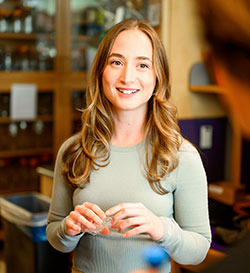Margaux Pinney

Assistant Professor (Affiliated) of Biochemistry, Biophysics and Structural Biology
Lab Homepage: https://pinneylab.com/Research Interests
Proteins underpin nearly every cellular process: enzymes catalyze chemical reactions, molecular switches control signaling, and membrane proteins connect cells to their environment. Traditional biochemistry, though powerful, has limited throughput and typically examines only a few variants and properties at a time. Selection-based screens offer higher throughput but can be convoluted, making it difficult to isolate the effects of individual mutations on specific biochemical properties.
The Pinney Lab overcomes these challenges by harnessing high-throughput, microfluidic-based methods that directly measure key biochemical constants for thousands of protein variants in a single experiment. Our approach uniquely combines scale and quantitative precision, enabling repeated assays with multiple substrates and conditions to efficiently generate high-dimensional biochemical datasets without sacrificing quantitative power for throughput. We apply these methods to investigate protein function, evolution, disease-causing, and drug-resistance mutations at an unprecedented scale, and aim to leverage this information to accelerate enzyme design and engineering. By integrating our datasets with machine learning and deep learning, we aim to predict biochemical properties directly from protein sequence.
Broadly, our goal is to map the sequence–function–phenotype landscapes of proteins. Some of the key questions we ask include:
- How does sequence encode quantitative properties such as activity, stability, specificity, inhibition, and regulation?
- How are landscapes warped by different environmental conditions?
- How has natural evolution navigated these landscapes, and how have epistasis and historical contingencies shaped evolutionary trajectories, potentially towards suboptimal outcomes?
- How do different property landscapes—such as activity and stability—overlap, synergize, or trade off?
- How do quantitative biochemical properties translate to cellular phenotypes—which quantitative functions matter, when, and why?
- How can we use this understanding to engineer enzymes with improved or novel properties, both through rational design and in combination with machine learning and deep learning?
- How can our microfluidic methods be extended to study the biophysics of other protein classes, including intrinsically disordered and membrane proteins?
Selected Publications
Muir DF, Asper GPR, Notin P, Posner JA, Marks DS, Keiser MJ, Pinney MM. Evolutionary-scale enzymology enables exploration of a rugged catalytic landscape. Science. 2025;388(6752):eadu1058. PMID: 40504906
Pinney MM, Mokhtari DA, Akiva E, Yabukarski F, Sanchez DM, Liang R, Doukov T, Martinez TJ, Babbitt PC, Herschlag D. Parallel molecular mechanisms for enzyme temperature adaptation. Science. 2021 Mar 5;371(6533). doi: 10.1126/science.aay2784. PubMed PMID: 33674467.
Last Updated 2025-08-15